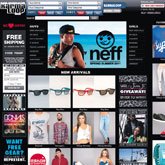Rush to M-Commerce
Retailers push to sell in the mobile commerce market.
In a still-sluggish economy, many retailers are bullish about one field: mobile commerce.
In the past year, companies as diverse as mass merchant Target Corp.; specialty chain The Wet Seal Inc.; HauteLook Inc., the flash-sale site recently acquired by Nordstrom Inc.; and pure play e-commerce retailer Karmaloop. com all have invested capital to take advantage of the growing m-commerce market, where consumers shop and make purchases on their smart phones.
But there are many unanswered questions regarding which direction m-commerce will take and how to best engage consumers, said Joseph Finsterwald, chief technology officer of Boston-based Karmaloop. “We’re just at the beginning,” he said.
M-commerce has been on retailers’ radar screens for the past 10 years, but it was the overwhelming popularity of the iPhone and sales for other smart phone models that convinced many businesses that there was a lucrative future in m-commerce.
Market-research companies forecast m-commerce will skyrocket when smart phones enabled with m-commerce technology are more widely distributed.
United Kingdom–based Juniper Research Ltd. published a study on April 14 forecasting that by 2014, one in five smart phones across the world will be enabled with the Near Field Communication wireless technology. NFC chips enable phones to make credit and debit payments. Half of these NFC-enabled phones will be owned by consumers in North America, according to this study. Bluetooth-enabled phones also have the ability to make payments.
Mobile ad network InMobi recently released a study that found 35 percent of consumers are comfortable with shopping by smart phone.
There already is a significant surge in corporate support for m-commerce. On April 27, global payments company Visa Inc. announced its guidelines for best practices or good citizenship for m-commerce. The rules will help retailers, software designers and device manufacturers guard against fraud and ensure safe payments for those consumers using m-commerce, said Eduardo Perez, head of Visa’s global payment-system risk.
On the same day, it was announced that Visa made an undisclosed investment in San Francisco company technology company Square Inc., which makes a credit-card reader that can be attached to mobile devices such as smart phones and tablets. Square’s credit-card reader can be used by small businesses that previously had no access to the payments industry.
More than just e-commerce
Technology companies hope to invite more retailers into this burgeoning market. On April 11, the Digby Mobile Commerce service launched to build m-commerce websites for retailers. The company is a partnership between Austin, Texas– based technology company Digby and AT&T.
This new venture will build mobile websites and payment functions, as well as apps, which could feature anything ranging from reviews to coupons and graphics. On April 18, Digby announced $8 million in funding from its existing partners to further develop its Digby Mobile Commerce service.
This service is a new frontier that is different from e-commerce, said Dan Lowden, Digby’s vice president of marketing. “This is not a cut and paste of [e-commerce] content. This is a data feed that offers unique experiences on the phone,” Lowden said.
One crucial difference between mobile and e-commerce is size. E-commerce graphics files are much bigger than m-commerce files, and e-commerce files load too slowly on phones to provide a good customer experience, Lowden said. Only a mobile site can guarantee speedy navigation on phones.
There are some experiences best accessed by phone, according to Greg Bettinelli, senior vice president of marketing at HauteLook.
Many of the site’s first-come, first-serve deals are announced at 8 a.m., when many consumers are commuting to work or before people turn on their office computers. People use their phones to get first dibs on what is being sold.
On weekdays, m-commerce makes up 12 percent of HauteLook’s traffic. But some people prefer to shop by phone into the weekend, as well. Fifteen percent of HauteLook’s weekend traffic is m-commerce. By the end of 2011, the company expects m-commerce to make up 20 percent of HauteLook’s business overall. In 2010, HauteLook reported $100 million in sales. Bettinelli said his company is expanding its m-commerce applications. “We talk about customers taking HauteLook everywhere,” he said.
HauteLook currently can be accessed by smart phone, Facebook and the company’s website. This summer, HauteLook will debut applications for iPads and Android smart phone systems.
iPads pose a new challenge to m-commerce. The larger iPad screen, which spans 9.7 inches diagonally, according to Apple, compared with the 3.5-inch diagonal measurement of the iPhone screen, makes it easier to browse and scan details of clothes.
The iPad could also provide an opportunity to capture shoppers who don’t like the small screen on a smart phone.
“When I’m shopping online, I like to see 10 products at once; you can’t do that on a phone,” said Shannah Katz, a senior at California State University, Long Beach.
Cross-platform shopping
Some retailers got the m-commerce ball rolling by offering bar codes for download. Target consumers, for example, can take advantage of special deals at the mass retailer with mobile coupons that can be redeemed by scanning a bar code at a Target checkout register.
Juniors retailer Wet Seal created a special in-store/mobile partnership to keep the shopping experience moving from online to in-store.
The iRunway app, produced by the Foothill Ranch, Calif.– based retailer, lets shoppers view outfits created by their friends. iRunway users can scan bar codes of an item and see how friends used the garment in an outfit on the iRunway site, said Shari Rudolph, Wet Seal Inc.’s vice president of e-commerce.
Programs like these could drive more foot traffic to physical stores, according to Marshal Cohen, chief industry analyst with market-research company The NPD Group. But m-commerce will take market share away from e-commerce, Cohen said. “After all, who needs to run home to your laptop when your phone is right there?”
























